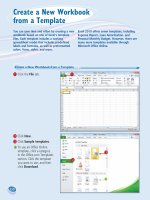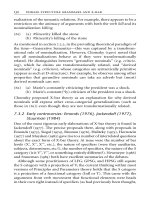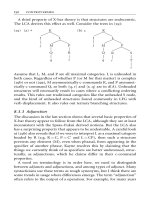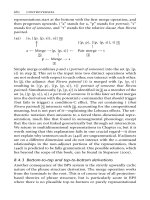Tài liệu Less-Numerical Algorithms part 5 pptx
Bạn đang xem bản rút gọn của tài liệu. Xem và tải ngay bản đầy đủ của tài liệu tại đây (131.83 KB, 8 trang )
20.4 Huffman Coding and Compression of Data
903
Sample page from NUMERICAL RECIPES IN C: THE ART OF SCIENTIFIC COMPUTING (ISBN 0-521-43108-5)
Copyright (C) 1988-1992 by Cambridge University Press.Programs Copyright (C) 1988-1992 by Numerical Recipes Software.
Permission is granted for internet users to make one paper copy for their own personal use. Further reproduction, or any copying of machine-
readable files (including this one) to any servercomputer, is strictly prohibited. To order Numerical Recipes books,diskettes, or CDROMs
visit website or call 1-800-872-7423 (North America only),or send email to (outside North America).
k=ij[k][ip[(c+2) % 10][7 & m++]];
}
for (j=0;j<=9;j++) Find which appended digit will check properly.
if (!ij[k][ip[j][m & 7]]) break;
*ch=j+48; Convert to ASCII.
return k==0;
}
CITED REFERENCES AND FURTHER READING:
McNamara, J.E. 1982,
Technical Aspects of Data Communication
, 2nd ed. (Bedford, MA: Digital
Press). [1]
da Cruz, F. 1987,
Kermit, A File Transfer Protocol
(Bedford, MA: Digital Press). [2]
Morse, G. 1986,
Byte
, vol. 11, pp. 115–124 (September). [3]
LeVan, J. 1987,
Byte
, vol. 12, pp. 339–341 (November). [4]
Sarwate, D.V. 1988,
Communications of the ACM
, vol. 31, pp. 1008–1013. [5]
Griffiths, G., and Stones, G.C. 1987,
Communications of the ACM
, vol. 30, pp. 617–620. [6]
Wagner, N.R., and Putter, P.S. 1989,
Communications of the ACM
, vol. 32, pp. 106–110. [7]
20.4 Huffman Coding and Compression of Data
A lossless data compression algorithm takes a string of symbols (typically
ASCII characters or bytes) and translates it reversibly into another string, one that
is on the average of shorter length. The words “on the average” are crucial; it
is obvious that no reversible algorithm can make all strings shorter — there just
aren’t enough short strings to be in one-to-one correspondence with longer strings.
Compression algorithms are possible only when, on the input side, some strings, or
some input symbols, are more common than others. These can then be encoded in
fewer bits than rarer input strings or symbols, giving a net average gain.
There exist many, quite different, compression techniques, corresponding to
different waysofdetecting and usingdepartures from equiprobabilityin inputstrings.
In thissection and the next we shall consider only variablelength codes with defined
word inputs. In these, the input is sliced into fixed units, for example ASCII
characters, while the corresponding output comes in chunks of variable size. The
simplest such method is Huffman coding
[1]
, discussed in this section. Another
example, arithmetic compression, is discussed in §20.5.
At the opposite extreme from defined-word, variable length codes are schemes
that divideup the inputintounitsof variable length (wordsor phrases of Englishtext,
for example) and thentransmit these, often witha fixed-lengthoutput code. The most
widely used code of this type is the Ziv-Lempel code
[2]
. References
[3-6]
give the
flavor of some other compression techniques, with references to the large literature.
The idea behind Huffman coding is simply to use shorter bit patterns for more
common characters. We can make this idea quantitative by considering the concept
of entropy. Suppose the input alphabet has N
ch
characters, and that these occur in
the input string with respective probabilities p
i
, i =1, ,N
ch
,sothat
p
i
=1.
Then the fundamental theorem of information theory says that strings consisting of
904
Chapter 20. Less-Numerical Algorithms
Sample page from NUMERICAL RECIPES IN C: THE ART OF SCIENTIFIC COMPUTING (ISBN 0-521-43108-5)
Copyright (C) 1988-1992 by Cambridge University Press.Programs Copyright (C) 1988-1992 by Numerical Recipes Software.
Permission is granted for internet users to make one paper copy for their own personal use. Further reproduction, or any copying of machine-
readable files (including this one) to any servercomputer, is strictly prohibited. To order Numerical Recipes books,diskettes, or CDROMs
visit website or call 1-800-872-7423 (North America only),or send email to (outside North America).
independently random sequences of these characters (a conservative, but not always
realistic assumption) require, on the average, at least
H = −
p
i
log
2
p
i
(20.4.1)
bits per character. Here H is the entropy of the probability distribution. Moreover,
coding schemes exist which approach the bound arbitrarily closely. For the case of
equiprobable characters, with all p
i
=1/N
ch
, one easily sees that H =log
2
N
ch
,
which is the case of no compression at all. Any other set of p
i
’s gives a smaller
entropy, allowing some useful compression.
Noticethatthe boundof(20.4.1) wouldbe achieved ifwe couldencodecharacter
i with a code of length L
i
= − log
2
p
i
bits: Equation (20.4.1) would then be the
average
p
i
L
i
. The trouble with such a scheme is that − log
2
p
i
is not generally
an integer. How can we encode the letter “Q” in 5.32 bits? Huffman coding makes
a stab at this by, in effect, approximating all the probabilities p
i
by integer powers
of 1/2, so that all the L
i
’s are integral. If all the p
i
’s are in fact of this form, then a
Huffman code does achieve the entropy bound H.
The construction of a Huffman code is best illustrated by example. Imagine
a language, Vowellish, with the N
ch
=5character alphabet A, E, I, O, and U,
occurring with the respective probabilities 0.12, 0.42, 0.09, 0.30, and 0.07. Then the
constructionof a Huffman code for Vowellish is accomplished in the following table:
Node Stage: 1 2 3 4 5
1 A: 0.12 0.12
2 E: 0.42 0.42 0.42 0.42
3 I: 0.09
4 O: 0.30 0.30 0.30
5 U: 0.07
6 UI: 0.16
7 AUI: 0.28
8 AUIO: 0.58
9 EAUIO: 1.00
Here is how it works, proceeding in sequence through N
ch
stages, represented
by the columns of the table. The first stage starts with N
ch
nodes, one for each
letter of the alphabet, containing their respective relative frequencies. At each stage,
the two smallest probabilities are found, summed to make a new node, and then
dropped from the list of active nodes. (A “block” denotes the stage where a node is
dropped.) All active nodes (including the new composite) are then carried over to
the next stage (column). In the table, the names assigned to new nodes (e.g., AUI)
are inconsequential. In the example shown, it happens that (after stage 1) the two
20.4 Huffman Coding and Compression of Data
905
Sample page from NUMERICAL RECIPES IN C: THE ART OF SCIENTIFIC COMPUTING (ISBN 0-521-43108-5)
Copyright (C) 1988-1992 by Cambridge University Press.Programs Copyright (C) 1988-1992 by Numerical Recipes Software.
Permission is granted for internet users to make one paper copy for their own personal use. Further reproduction, or any copying of machine-
readable files (including this one) to any servercomputer, is strictly prohibited. To order Numerical Recipes books,diskettes, or CDROMs
visit website or call 1-800-872-7423 (North America only),or send email to (outside North America).
E
EAUIO
A
U
AUI
AUIO
UI
I
O
1.00
0.58
0.28 0.30
0.090.07
3
5
0.166
0.12
0.422
9
8
7
4
1
10
10
10
10
Figure 20.4.1. Huffman code for the fictitious language Vowellish, in tree form. A letter (A, E, I,
O, or U) is encoded or decoded by traversing the tree from the top down; the code is the sequence of
0’s and 1’s on the branches. The value to the right of each node is its probability; to the left, its node
number in the accompanying table.
smallest nodes are always an original node and a composite one; this need not be
true in general: The two smallest probabilities might be both original nodes, or both
composites, or one of each. At the last stage, all nodes will have been collected into
one grand composite of total probability 1.
Now, to see the code, you redraw the data in the above table as a tree (Figure
20.4.1). As shown, each node of the tree corresponds to a node (row) in the table,
indicated by the integer to its left and probability value to its right. Terminal nodes,
so called, are shown as circles; these are single alphabetic characters. The branches
of the tree are labeled 0 and 1. The code for a character is the sequence of zeros and
ones that lead to it, from the top down. For example, E is simply 0, while U is 1010.
Any string of zeros and ones can now be decoded into an alphabetic sequence.
Consider, for example, the string 1011111010. Starting at the top of the tree we
descend through 1011 to I, the first character. Since we have reached a terminal
node, we reset to the top of the tree, next descending through 11 to O. Finally 1010
gives U. The string thus decodes to IOU.
These ideas are embodied in the following routines. Input to the first routine
hufmak is an integer vector of the frequency of occurrence of the nchin ≡ N
ch
alphabetic characters, i.e., a set of integers proportional to the p
i
’s. hufmak, along
withhufapp, which it calls, performsthe constructionof the abovetable, and also the
tree of Figure 20.4.1. The routine utilizes a heap structure (see §8.3) for efficiency;
for a detailed description, see Sedgewick
[7]
.
906
Chapter 20. Less-Numerical Algorithms
Sample page from NUMERICAL RECIPES IN C: THE ART OF SCIENTIFIC COMPUTING (ISBN 0-521-43108-5)
Copyright (C) 1988-1992 by Cambridge University Press.Programs Copyright (C) 1988-1992 by Numerical Recipes Software.
Permission is granted for internet users to make one paper copy for their own personal use. Further reproduction, or any copying of machine-
readable files (including this one) to any servercomputer, is strictly prohibited. To order Numerical Recipes books,diskettes, or CDROMs
visit website or call 1-800-872-7423 (North America only),or send email to (outside North America).
#include "nrutil.h"
typedef struct {
unsigned long *icod,*ncod,*left,*right,nch,nodemax;
} huffcode;
void hufmak(unsigned long nfreq[], unsigned long nchin, unsigned long *ilong,
unsigned long *nlong, huffcode *hcode)
Given the frequency of occurrence table
nfreq[1 nchin] of nchin characters, construct the
Huffman code in the structure
hcode. Returned values ilong and nlong are the character
number that produced the longest code symbol, and the length of that symbol. You should
check that
nlong is not larger than your machine’s word length.
{
void hufapp(unsigned long index[], unsigned long nprob[], unsigned long n,
unsigned long i);
int ibit;
long node,*up;
unsigned long j,k,*index,n,nused,*nprob;
static unsigned long setbit[32]={0x1L,0x2L,0x4L,0x8L,0x10L,0x20L,
0x40L,0x80L,0x100L,0x200L,0x400L,0x800L,0x1000L,0x2000L,
0x4000L,0x8000L,0x10000L,0x20000L,0x40000L,0x80000L,0x100000L,
0x200000L,0x400000L,0x800000L,0x1000000L,0x2000000L,0x4000000L,
0x8000000L,0x10000000L,0x20000000L,0x40000000L,0x80000000L};
hcode->nch=nchin; Initialization.
index=lvector(1,(long)(2*hcode->nch-1));
up=(long *)lvector(1,(long)(2*hcode->nch-1)); Vector that will keep track of
heap.nprob=lvector(1,(long)(2*hcode->nch-1));
for (nused=0,j=1;j<=hcode->nch;j++) {
nprob[j]=nfreq[j];
hcode->icod[j]=hcode->ncod[j]=0;
if (nfreq[j]) index[++nused]=j;
}
for (j=nused;j>=1;j ) hufapp(index,nprob,nused,j);
Sort nprob into a heap structure in index.
k=hcode->nch;
while (nused > 1) { Combine heap nodes, remaking
the heap at each stage.node=index[1];
index[1]=index[nused ];
hufapp(index,nprob,nused,1);
nprob[++k]=nprob[index[1]]+nprob[node];
hcode->left[k]=node; Store left and right children of a
node.hcode->right[k]=index[1];
up[index[1]] = -(long)k; Indicate whether a node is a left
or right child of its parent.up[node]=index[1]=k;
hufapp(index,nprob,nused,1);
}
up[hcode->nodemax=k]=0;
for (j=1;j<=hcode->nch;j++) { Make the Huffman code from
the tree.if (nprob[j]) {
for (n=0,ibit=0,node=up[j];node;node=up[node],ibit++) {
if (node < 0) {
n |= setbit[ibit];
node = -node;
}
}
hcode->icod[j]=n;
hcode->ncod[j]=ibit;
}
}
*nlong=0;
for (j=1;j<=hcode->nch;j++) {
if (hcode->ncod[j] > *nlong) {
*nlong=hcode->ncod[j];
20.4 Huffman Coding and Compression of Data
907
Sample page from NUMERICAL RECIPES IN C: THE ART OF SCIENTIFIC COMPUTING (ISBN 0-521-43108-5)
Copyright (C) 1988-1992 by Cambridge University Press.Programs Copyright (C) 1988-1992 by Numerical Recipes Software.
Permission is granted for internet users to make one paper copy for their own personal use. Further reproduction, or any copying of machine-
readable files (including this one) to any servercomputer, is strictly prohibited. To order Numerical Recipes books,diskettes, or CDROMs
visit website or call 1-800-872-7423 (North America only),or send email to (outside North America).
*ilong=j-1;
}
}
free_lvector(nprob,1,(long)(2*hcode->nch-1));
free_lvector((unsigned long *)up,1,(long)(2*hcode->nch-1));
free_lvector(index,1,(long)(2*hcode->nch-1));
}
void hufapp(unsigned long index[], unsigned long nprob[], unsigned long n,
unsigned long i)
Used by
hufmak to maintain a heap structure in the array index[1 l].
{
unsigned long j,k;
k=index[i];
while (i <= (n>>1)) {
if((j=i<<1)<n&&nprob[index[j]] > nprob[index[j+1]]) j++;
if (nprob[k] <= nprob[index[j]]) break;
index[i]=index[j];
i=j;
}
index[i]=k;
}
Note that the structure hcode must be defined and allocated in your main
program with statements like this:
#include "nrutil.h"
#define MC 512 Maximum anticipated value of nchin in hufmak.
#define MQ (2*MC-1)
typedef struct {
unsigned long *icod,*ncod,*left,*right,nch,nodemax;
} huffcode;
huffcode hcode;
hcode.icod=(unsigned long *)lvector(1,MQ); Allocate space within hcode.
hcode.ncod=(unsigned long *)lvector(1,MQ);
hcode.left=(unsigned long *)lvector(1,MQ);
hcode.right=(unsigned long *)lvector(1,MQ);
for (j=1;j<=MQ;j++) hcode.icod[j]=hcode.ncod[j]=0;
Once the code is constructed, one encodes a string of characters by repeated calls
to hufenc, which simply does a table lookup of the code and appends it to the
output message.
#include <stdio.h>
#include <stdlib.h>
typedef struct {
unsigned long *icod,*ncod,*left,*right,nch,nodemax;
} huffcode;
void hufenc(unsigned long ich, unsigned char **codep, unsigned long *lcode,
unsigned long *nb, huffcode *hcode)
Huffman encode the single character
ich (in the range 0 nch-1) using the code in the
structure
hcode, write the result to the character array *codep[1 lcode] starting at bit
nb (whose smallest valid value is zero), and increment nb appropriately. This routine is called
908
Chapter 20. Less-Numerical Algorithms
Sample page from NUMERICAL RECIPES IN C: THE ART OF SCIENTIFIC COMPUTING (ISBN 0-521-43108-5)
Copyright (C) 1988-1992 by Cambridge University Press.Programs Copyright (C) 1988-1992 by Numerical Recipes Software.
Permission is granted for internet users to make one paper copy for their own personal use. Further reproduction, or any copying of machine-
readable files (including this one) to any servercomputer, is strictly prohibited. To order Numerical Recipes books,diskettes, or CDROMs
visit website or call 1-800-872-7423 (North America only),or send email to (outside North America).
repeatedly to encode consecutive characters in a message, but must be preceded by a single
initializing call to
hufmak, which constructs hcode.
{
void nrerror(char error_text[]);
int l,n;
unsigned long k,nc;
static unsigned long setbit[32]={0x1L,0x2L,0x4L,0x8L,0x10L,0x20L,
0x40L,0x80L,0x100L,0x200L,0x400L,0x800L,0x1000L,0x2000L,
0x4000L,0x8000L,0x10000L,0x20000L,0x40000L,0x80000L,0x100000L,
0x200000L,0x400000L,0x800000L,0x1000000L,0x2000000L,0x4000000L,
0x8000000L,0x10000000L,0x20000000L,0x40000000L,0x80000000L};
k=ich+1;
Convert character range 0 nch-1 toarrayindexrange1 nch.
if (k > hcode->nch ||k<1)nrerror("ich out of range in hufenc.");
for (n=hcode->ncod[k]-1;n>=0;n ,++(*nb)) { Loop over the bits in the stored
Huffman code for ich.nc=(*nb >> 3);
if (++nc >= *lcode) {
fprintf(stderr,"Reached the end of the ’code’ array.\n");
fprintf(stderr,"Attempting to expand its size.\n");
*lcode *= 1.5;
if ((*codep=(unsigned char *)realloc(*codep,
(unsigned)(*lcode*sizeof(unsigned char)))) == NULL) {
nrerror("Size expansion failed.");
}
}
l=(*nb) & 7;
if (!l) (*codep)[nc]=0; Set appropriate bits in code.
if (hcode->icod[k] & setbit[n]) (*codep)[nc] |= setbit[l];
}
}
Decoding a Huffman-encoded message is slightly more complicated. The
coding tree must be traversed from the top down, using up a variable number of bits:
typedef struct {
unsigned long *icod,*ncod,*left,*right,nch,nodemax;
} huffcode;
void hufdec(unsigned long *ich, unsigned char *code, unsigned long lcode,
unsigned long *nb, huffcode *hcode)
Starting at bit number
nb in the character array code[1 lcode], use the Huffman code stored
in the structure
hcode to decode a single character (returned as ich in the range 0 nch-1)
and increment
nb appropriately. Repeated calls, starting with nb =0will return successive
characters in a compressed message. The returned value
ich=nch indicates end-of-message.
The structure
hcode must already have been defined and allocated in your main program, and
also filled by a call to
hufmak.
{
long nc,node;
static unsigned char setbit[8]={0x1,0x2,0x4,0x8,0x10,0x20,0x40,0x80};
node=hcode->nodemax;
for (;;) { Set node to the top of the decoding tree, and loop
until a valid character is obtained.nc=(*nb >> 3);
if (++nc > lcode) { Ran out of input; with ich=nch indicating end of
message.*ich=hcode->nch;
return;
}
node=(code[nc] & setbit[7 & (*nb)++] ?
hcode->right[node] : hcode->left[node]);
Branch left or right in tree, depending on its value.
if (node <= hcode->nch) { If we reach a terminal node, we have a complete
character and can return.
20.4 Huffman Coding and Compression of Data
909
Sample page from NUMERICAL RECIPES IN C: THE ART OF SCIENTIFIC COMPUTING (ISBN 0-521-43108-5)
Copyright (C) 1988-1992 by Cambridge University Press.Programs Copyright (C) 1988-1992 by Numerical Recipes Software.
Permission is granted for internet users to make one paper copy for their own personal use. Further reproduction, or any copying of machine-
readable files (including this one) to any servercomputer, is strictly prohibited. To order Numerical Recipes books,diskettes, or CDROMs
visit website or call 1-800-872-7423 (North America only),or send email to (outside North America).
*ich=node-1;
return;
}
}
}
For simplicity, hufdec quits when it runs out of code bytes; if your coded
message is not an integral number of bytes, and if N
ch
is less than 256, hufdec
can return a spurious final character or two, decoded from the spurious trailing
bits in your last code byte. If you have independent knowledge of the number of
characters sent, you can readily discard these. Otherwise, you can fix this behavior
by providing a bit, not byte, count, and modifying the routine accordingly. (When
N
ch
is 256 or larger, hufdec will normally run out of code in the middle of a
spurious character, and it will be discarded.)
Run-Length Encoding
For the compression of highly correlated bit-streams (for example the black or
white values along a facsimile scan line), Huffman compression is often combined
with run-length encoding: Instead of sending each bit, the input stream is converted
to a series of integers indicating how many consecutive bits have the same value.
These integers are then Huffman-compressed. The Group 3 CCITT facsimile
standard functionsin this manner, with a fixed, immutable, Huffman code, optimized
for a set of eight standard documents
[8,9]
.
CITED REFERENCES AND FURTHER READING:
Gallager, R.G. 1968,
Information Theory and Reliable Communication
(New York: Wiley).
Hamming, R.W. 1980,
Coding and Information Theory
(Englewood Cliffs, NJ: Prentice-Hall).
Storer, J.A. 1988,
Data Compression: Methods and Theory
(Rockville, MD: Computer Science
Press).
Nelson, M. 1991,
The Data Compression Book
(Redwood City, CA: M&T Books).
Huffman, D.A. 1952,
Proceedings of the Institute of Radio Engineers
, vol. 40, pp. 1098–1101. [1]
Ziv, J., and Lempel, A. 1978,
IEEE Transactions on Information Theory
, vol. IT-24, pp. 530–536.
[2]
Cleary, J.G., and Witten, I.H. 1984,
IEEE Transactions on Communications
, vol. COM-32,
pp. 396–402. [3]
Welch, T.A. 1984,
Computer
, vol. 17, no. 6, pp. 8–19. [4]
Bentley, J.L., Sleator, D.D., Tarjan, R.E., and Wei, V.K. 1986,
Communications of the ACM
,
vol. 29, pp. 320–330. [5]
Jones, D.W. 1988,
Communications of the ACM
, vol. 31, pp. 996–1007. [6]
Sedgewick, R. 1988,
Algorithms
, 2nd ed. (Reading, MA: Addison-Wesley), Chapter 22. [7]
Hunter, R., and Robinson, A.H. 1980,
Proceedings of the IEEE
, vol. 68, pp. 854–867. [8]
Marking, M.P. 1990,
The C Users’ Journal
, vol. 8, no. 6, pp. 45–54. [9]
910
Chapter 20. Less-Numerical Algorithms
Sample page from NUMERICAL RECIPES IN C: THE ART OF SCIENTIFIC COMPUTING (ISBN 0-521-43108-5)
Copyright (C) 1988-1992 by Cambridge University Press.Programs Copyright (C) 1988-1992 by Numerical Recipes Software.
Permission is granted for internet users to make one paper copy for their own personal use. Further reproduction, or any copying of machine-
readable files (including this one) to any servercomputer, is strictly prohibited. To order Numerical Recipes books,diskettes, or CDROMs
visit website or call 1-800-872-7423 (North America only),or send email to (outside North America).
20.5 Arithmetic Coding
We saw in the previous section that a perfect (entropy-bounded)coding scheme
would use L
i
= − log
2
p
i
bits to encode character i (in the range 1 ≤ i ≤ N
ch
),
if p
i
is its probability of occurrence. Huffman coding gives a way of rounding the
L
i
’s to close integer values and constructing a code with those lengths. Arithmetic
coding
[1]
, which we now discuss, actually does manage to encode characters using
noninteger numbers of bits! It also provides a convenient way to output the result
not as a stream of bits, but as a stream of symbols in any desired radix. This latter
property is particularly useful if you want, e.g., to convert data from bytes (radix
256) to printable ASCII characters (radix 94), or to case-independent alphanumeric
sequences containing only A-Z and 0-9 (radix 36).
In arithmetic coding, an input message of any length is represented as a real
number R in the range 0 ≤ R<1. The longer the message, the more precision
required of R. This is best illustrated by an example, so let us return to the fictitious
language, Vowellish, of the previous section. Recall that Vowellish has a 5 character
alphabet (A, E, I, O, U), with occurrence probabilities 0.12, 0.42, 0.09, 0.30, and
0.07, respectively. Figure 20.5.1 shows how a message beginning “IOU” is encoded:
The interval [0, 1) is divided into segments corresponding to the 5 alphabetical
characters; the length of a segment is the corresponding p
i
. We see that the first
message character, “I”, narrows the range of R to 0.37 ≤ R<0.46. This interval is
now subdividedintofivesubintervals,again withlengthsproportionaltothep
i
’s. The
second message character, “O”, narrows the range of R to 0.3763 ≤ R<0.4033.
The “U” character further narrows the range to 0.37630 ≤ R<0.37819. Any value
of R in this range can be sent as encoding “IOU”. In particular, the binary fraction
.011000001 is in this range, so “IOU” can be sent in 9 bits. (Huffman coding took
10 bits for this example, see §20.4.)
Of course there is the problem of knowing when to stop decoding. The
fraction .011000001 represents not simply “IOU,” but “IOU ,” where the ellipses
represent an infinite string of successor characters. To resolve this ambiguity,
arithmetic coding generally assumes the existence of a special N
ch
+1th character,
EOM (end of message), which occurs only once at the end of the input. Since
EOM has a low probability of occurrence, it gets allocated only a very tiny piece
of the number line.
In the above example, we gave R as a binary fraction. We could just as well
have output it in any other radix, e.g., base 94 or base 36, whatever is convenient
for the anticipated storage or communication channel.
You might wonder how one deals with the seemingly incredible precision
required of R for a long message. The answer is that R is never actually represented
all at once. At any give stage we have upper and lower bounds for R represented
as a finite number of digits in the output radix. As digits of the upper and lower
bounds become identical, we can left-shift them away and bring in new digits at the
low-significance end. The routines below have a parameter NWK for the number of
working digits to keep around. This must be large enough to make the chance of
an accidental degeneracy vanishingly small. (The routines signal if a degeneracy
ever occurs.) Since the process of discarding old digits and bringing in new ones is
performed identically on encoding and decoding, everything stays synchronized.









